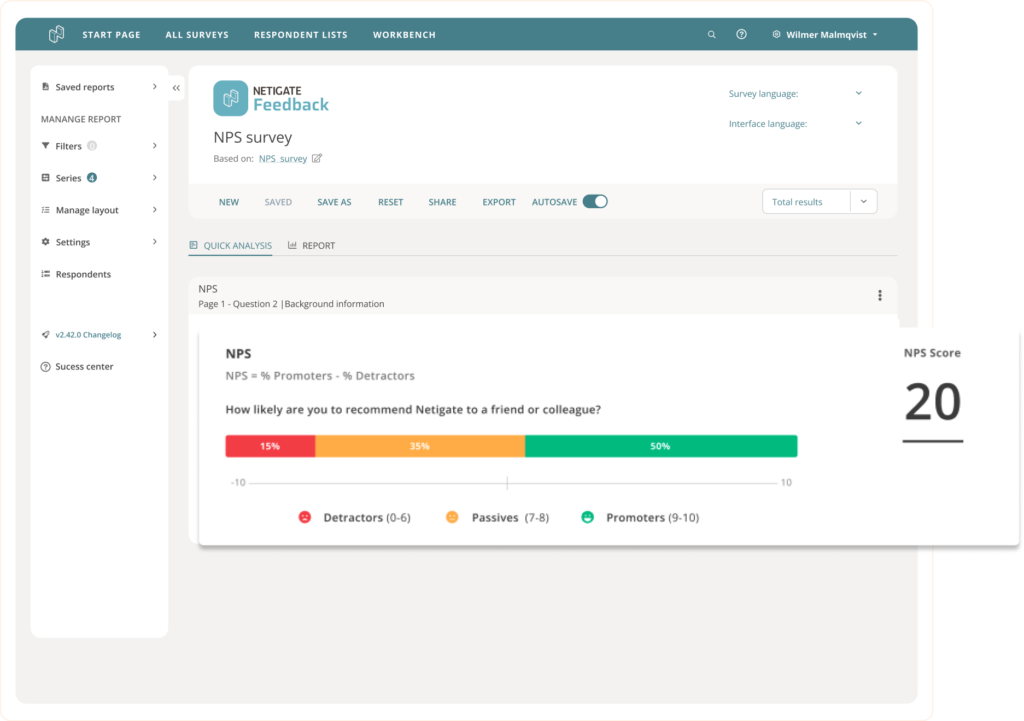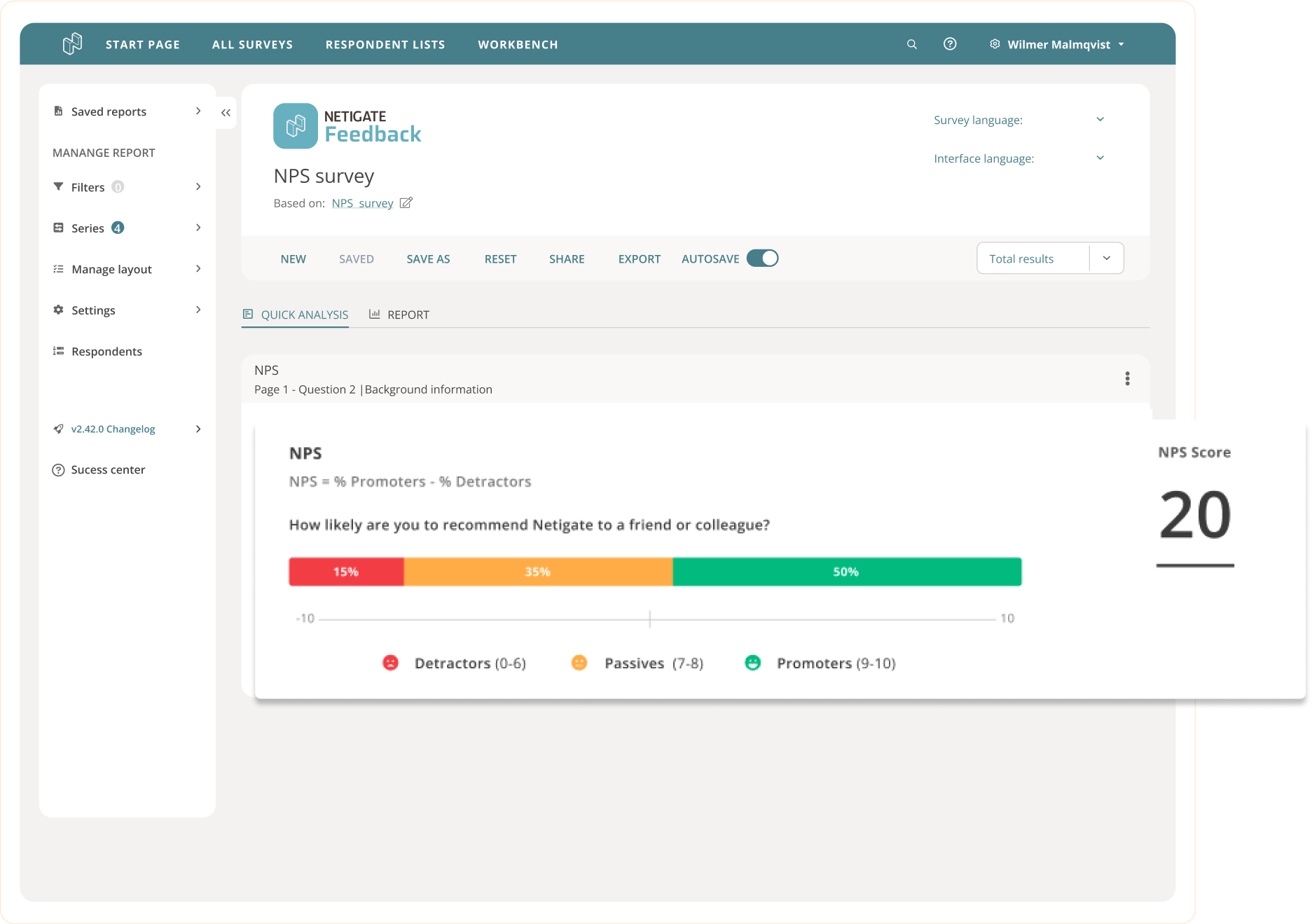Table of Contents
More Than Just A Number: Driving Change With NPS Surveys

Is the Net Promoter Score having a bit of a rough moment?
It started when the influential Wall Street Journal teed off on NPS, terming it a “dubious management fad” and noting its frequent mentions on S&P 500 companies’ earnings calls. This kicked off an avalanche of opinions, follow-up articles and conversations about whether NPS is really the magic bullet customer satisfaction metric many purport it to be.
NPS asks one simple question: “How likely is it for you to recommend our company to a friend or colleague?” Respondents give their answers on a scale from 0 to 10, which allows businesses to calculate a score that translates to an overall customer loyalty metric.
We at Netigate often advise customers on how they can best use an NPS software. Companies can use the NPS survey to gain valuable insights from their customers. This comes with the caveat: it’s only one part of the solution!
Like any score or metric, the final number is merely an outcome, one that shouldn’t stand on its own isolated from context. While many organisations tend to focus on hitting a certain NPS. Or improving it by a specific percentage, the score is not an end in itself.
Instead, the real value comes from the insights gained from running an NPS survey. And how you as a company react to the results. It’s a bit melodramatic to say it’s about the journey, not the destination. However it’s a pretty accurate description of how to think about NPS.
I’ll go through some of the benefits and acknowledged limitations of an NPS survey, and explain why I think they’re still worthwhile.
Quality in, Quality out
The insights that can come from NPS – or any other survey questions – are only as good as the quality of the collected data. In the WSJ piece, the authors recount stories of employees at Best Buy sharing tips on how to game the system for better scores. Examples include explaining to customers how the scoring works or only offering the survey to customers known to be satisfied or happy.
Of course, this will skew the results.
Other limitations include inherent cultural or other biases, as well as response rates, all of which will impact the final number. Customers from certain countries, like the United States, tend to give higher scores than others. But these nuances about the survey participants themselves don’t tend to be shared externally, whether in press releases or earnings calls.
While you don’t necessarily need to communicate all the minute details that go into your NPS score. It’s important that as a company you internally identify and acknowledge them. Then, work to eliminate bias or factors that can lead to a misleading score.
Questions to consider:
- Are all customers receiving the same opportunity to do an NPS survey?
- Are certain channels – email, phone call, web pop-up – over or under-performing and therefore affecting your results in a certain way?
- Or in an extreme scenario, are employees being incentivized to game the system?
NPS Survey: One Tool Out of Many

While NPS has been adopted widely, in large part because it is simple to understand and easy to implement. Ultimately there is no one metric to rule them all. Otherwise, we at Netigate wouldn’t offer a range of other services to help companies evaluate and improve customer satisfaction! NPS should be just one of many tools in your customer satisfaction toolkit.
An NPS survey cannot compete with a more in-depth customer satisfaction survey. Yes, a longer detailed survey will likely have a lower response rate, but the insights gained will be more qualitative and more comprehensive. Or consider the value of a customer service survey focused solely on the customer service experience.
Then there are customer churn surveys. Customer churn is a constant problem for all companies and one that NPS is unlikely to help you address in a substantive way. Surveys that target churned or about-to-churn customers can help you can understand your customers better, teach you how to adapt, and in the end prevent high churn rates for your business.
An over-reliance on NPS gives just a snapshot view of the customer journey. Rather than the overall picture that a broader, multi-faceted approach can bring.
Actions matter more than NPS alone
A colleague of ours here had the following experience:
“Around the start of 2019, I had a dentist appoint here in Stockholm that didn’t go so well. After my visit, I received a follow-up email from the dentist with an NPS survey. I gave them a negative rating and this prompted a message asking for permission to contact me about my experience. But I never heard from them again, and then I was automatically booked for another appointment – which annoyed me. I asked myself, are they even listening?”
This is a perfect example of what we advise customers at Netigate. We emphasize the need not just to collect data, but also turn that data into insights. And then act on those insights in a structured way.
Wall Street Journal’s article has a point in that it’s too easy to focus on the score. Especially when it’s tied to performance evaluations and benchmarking promotions or bonuses. Driving real change as an organisation requires listening to customers, which produces unbiased, high-quality data that can then be woven into an improved customer experience.
The score alone is not telling enough. How do you work with it is the bigger question.
-
Fabrizio Trotti
-
Fabrizio Trotti
- 4 min read
- .






